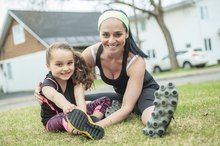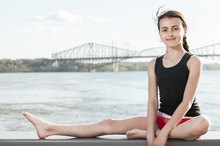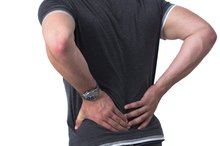Exercises to Help Femoral Anteversion
Femoral anteversion is a condition where the femoral neck tilts forward, which causes the lower leg to rotate inward. The condition is present in 10 percent of children and usually corrects itself with time. Only when the rotation is in excess of 50 degrees is the anteversion considered a problem. Parents with children who exhibit signs of femoral anteversion may have their children perform easy exercises to help reduce the force placed on the femur.
Conscious Walking
Children who are 8 to 10 years of age are more conscious of their bodies and can pay better attention to the mechanics of their stride. They should be instructed to take care to point their toes forward when they walk. This helps to train the muscles to work properly, which also helps reduce the stress on the thigh bones. Your child should work to be constantly conscious of her toe direction.
- Children who are 8 to 10 years of age are more conscious of their bodies and can pay better attention to the mechanics of their stride.
- They should be instructed to take care to point their toes forward when they walk.
Bridging Exercise
Scoliosis Exercises for Children
Learn More
The bridge exercise is a torso stability exercise that forces the femur to align properly with the hip and knee. The child should lie on his back with his knees bent and his feet flat on the floor, hip distance apart. He should take a deep breath in, then exhale and press his upper back into the floor as he lifts his hips up off the floor. He should press his feet into the floor and squeeze his butt muscles together. His lower body should come up so that a straight line should form from his shoulders to his hips. Next, he should inhale, still in the upper position, and then exhale as he slowly lowers to the starting position. Have him do five repetitions of this exercise. Have your child do this exercise every day.
- The bridge exercise is a torso stability exercise that forces the femur to align properly with the hip and knee.
- He should press his feet into the floor and squeeze his butt muscles together.
Backward Walking
For toddlers, it is more difficult to have them be conscious of which direction their toes point when they walk, but they are able to do other fun activities. Backward walking is one example. This move helps to strengthen the muscles of the hips and can lessen the force exerted on the femurs. Have your toddler walk forward 10 steps, then back nine steps -- or more -- if you are able to do these exercises outside. Do this every day.
- For toddlers, it is more difficult to have them be conscious of which direction their toes point when they walk, but they are able to do other fun activities.
In Severe Cases
Exercises to Help Toe Walking Kids
Learn More
Most -- 99 percent -- of femoral anteversion cases correct themselves. In severe cases, surgery may be considered, but only in older children. It is a very high-risk surgery. Children who suffer from mild cases of femoral anteversion are not any more likely to suffer from arthritis or other problems than children who have normal femoral development.
- Most -- 99 percent -- of femoral anteversion cases correct themselves.
- In severe cases, surgery may be considered, but only in older children.
Related Articles
References
- Strength Training Anatomy; Frederic Delavier
- American Academy of Orthopaedic Surgeons: Intoeing
- Kids Home Therapy: Femoral Anteversion
- MedlinePlus. Coronary angiogram. February 22, 2018.
- MedlinePlus. Blood gases. Updated July 20, 2018.
- Jindeel A. Claudication: a teachable moment or missed opportunity! Clin Med Rev Case Rep. 2017;4:186. doi:10.23937/2378-3656/1410186
- Niino T, Unosawa S, Kimura H. Ruptured common femoral artery aneurysm or abdominal aortic aneurysm? Case Rep Surg. 2013;2013:306987. doi:10.1155/2013/306987
- Stanford Medical Hospital. Femoral popliteal bypass.
- UCSD’s Practical Guide to Clinical Medicine. University of California San Diego website.
- Femoral Artery. Kenhub GmbH website.
- Femoropopliteal & Femorodistal Bypass. Circulation Foundation website.
- Lew, Valerie. Kang, Michael. Anatomy, Abdomen, and Pelvis, Femoral Sheath. Treasure Island, FL: StatPearls Publishing, LLC.; 2019.
- Menard M, Belkin M. Peripheral aneurysms. Comprehensive Vascular and Endovascular Surgery. 2009;2:579-91. doi:10.1016/B978-0-323-05726-4.00036-6
Writer Bio
Rick Rockwell is a self-employed personal trainer and experienced freelance writer. His articles have been published throughout the Internet. He has more than eight years of experience as a certified personal trainer, group fitness instructor and lifestyle coach. His company, Rockwell Fitness, is dedicated to educating and empowering others to live healthy lifestyles.









